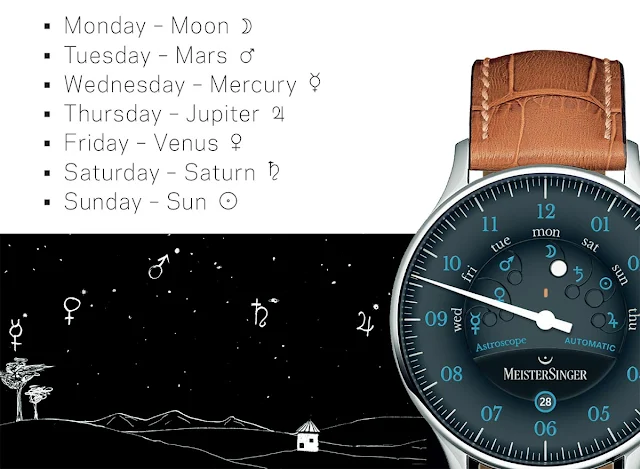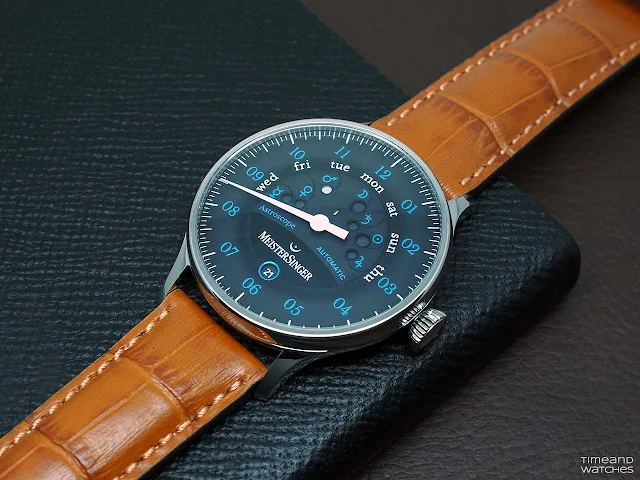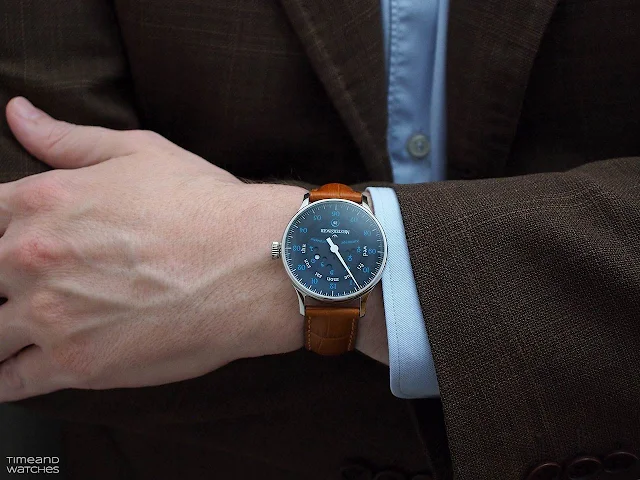Review MeisterSinger Astroscope. We recently had the opportunity to test and wear the Astroscope ref. AS902B for an entire week and we are now very pleased to share our impressions and pictures with our readers. Produced with meticulous attention to details, the new MeisterSinger Astroscope ref. AS902B has a retail price of Euro 1,990 which is in line with the high manufacturing quality of the timepiece, its original complication and a truly unique look.
The new MeisterSinger Astroscope is without doubts an unusual timepiece. Not only it has the peculiarity of displaying the time by means of a single hand like most timepieces of the German brand, but it also indicates the day of the week in an unprecedented way.
We recently had the opportunity to test and wear this eye-catching timepiece for an entire week and we are now very pleased to share our impressions and pictures with our readers.
The only hand of the Astroscope sweeps over the 12 hours divided by 144 markers, each representing 5 minutes. Reading the time in this way is easy and, why not, even fun once you get accustomed to the philosophy of a more relaxed way to consider the passing of time.
After the Lunascope launched in 2018 (you can read our review here), the Astroscope is MeisterSinger's second astronomical watch. We can place it in this category because it develops an astronomical theme - and definitely an original one - by displaying the days of the week in a fascinating way, i.e. by associating each day to the heavenly body that gives it its name.
In fact, the names of the days of the week in most languages are derived from the names of the classical planets in Hellenistic astrology, which were in turn brought from Mesopotomia.
In the 4th century, the Emperor Constantine the Great grafted this astrological system onto the Roman calendar, imposing the following sequence and names to the days of the week:
Dies Solis (Sun) ☉
Dies Lunae (Moon) ☽
Dies Martis (Mars) ♂
Dies Mercurii (Mercury) ☿
Dies Jovis (Jupiter) ♃
Dies Veneris (Venus) ♀
Dies Saturni (Saturn) ♄
This new system spread throughout the Roman Empire and was adopted, with some modifications, throughout most of western Europe: in the Germanic languages, such as Old English, the names of four of the Roman gods were converted into those of the corresponding Germanic gods.
With these celestial bodies and their classical symbols, the Astroscope shows the days of the week not in a linear or radial fashion but wandering back and forth in a constellation that only occurs every ten to twelve years in the southern night sky of the northern hemisphere. Such rare event will recur again in July 2020, when all the celestial bodies of the weekdays - Sun excluded - will be visible at the same time.
The Astroscope stylizes this formation on its dial; a bright dot appears on Monday at about 12 o’clock at the Moon symbol and the next day to the right at the Mars symbol. On Wednesday it appears next to Mercury at about 9 o’clock; on Thursday next to Jupiter at 3 o’clock, and so on.
The dot appearing next to the day of the week only apparently jumps back and forth. In reality, under the dial a large weekday disk with a number of bright dots on it moves from one day to the next moving in a circle.
When filled with yellow, the small indicator placed above the centre of the dial confirms that the day of the week has been correctly set.
Thanks to its colours and layout, the dial is very attractive with its blue numerals displayed in a fine serif typeface and clearly standing out against a matte black background. The dial is not flat but alternates convex and concave surfaces that add depth to the ensemble. Above the circular date window and the MeisterSinger logo there is an intimated horizon, enhancing the impression of looking up at the sky.
The hand, the indices and the days of the week are treated with a white luminescent coating that emits a blue glow if the dial was previously exposed to artificial or natural light.
The round case is 40 mm in diameter and 10.5 mm high, domed sapphire crystal included. Crafted from stainless steel, it features a polished finish that enhances the elegance of the timepiece. It guarantees water-resistance up to 5 bar (approximately 50 metres / 165 feet).
The lugs are slightly curved for excellent comfort on the wrist. The extra-large crown is adorned with an embossed MeisterSinger logo - the musical notation for a pause.
Visible through the sixfold screwed glass exhibition back, the self-winding movement is based on the highly reliable extensively tested Sellita SW 220-1 and customized with MeisterSinger finishes that include the engraving of the company's logo on the rotor. Beating at a frequency of 4 Hz (28,800 vibrations per hour) and equipped with an Incabloc antishock system, it guarantees a power reserve of 38 hours.
The watch is matched to a cognac-toned leather strap with a stainless steel pin buckle. A wide range of straps in other colours and materials or a stainless steel Milanaise bracelet are optionally available.
Produced with meticulous attention to details, the new MeisterSinger Astroscope ref. AS902B has a retail price of Euro 1,990 which is in line with the high manufacturing quality of the timepiece, its original complication and a truly unique look.
The Astroscope is also available in a variation with "Old Radium" numerals in place of the blue ones and brown leather strap (ref. AS902OR). meistersinger.com
We recently had the opportunity to test and wear this eye-catching timepiece for an entire week and we are now very pleased to share our impressions and pictures with our readers.
After the Lunascope launched in 2018 (you can read our review here), the Astroscope is MeisterSinger's second astronomical watch. We can place it in this category because it develops an astronomical theme - and definitely an original one - by displaying the days of the week in a fascinating way, i.e. by associating each day to the heavenly body that gives it its name.
In fact, the names of the days of the week in most languages are derived from the names of the classical planets in Hellenistic astrology, which were in turn brought from Mesopotomia.
In the 4th century, the Emperor Constantine the Great grafted this astrological system onto the Roman calendar, imposing the following sequence and names to the days of the week:
Dies Solis (Sun) ☉
Dies Lunae (Moon) ☽
Dies Martis (Mars) ♂
Dies Mercurii (Mercury) ☿
Dies Jovis (Jupiter) ♃
Dies Veneris (Venus) ♀
Dies Saturni (Saturn) ♄
This new system spread throughout the Roman Empire and was adopted, with some modifications, throughout most of western Europe: in the Germanic languages, such as Old English, the names of four of the Roman gods were converted into those of the corresponding Germanic gods.
With these celestial bodies and their classical symbols, the Astroscope shows the days of the week not in a linear or radial fashion but wandering back and forth in a constellation that only occurs every ten to twelve years in the southern night sky of the northern hemisphere. Such rare event will recur again in July 2020, when all the celestial bodies of the weekdays - Sun excluded - will be visible at the same time.
The dot appearing next to the day of the week only apparently jumps back and forth. In reality, under the dial a large weekday disk with a number of bright dots on it moves from one day to the next moving in a circle.
When filled with yellow, the small indicator placed above the centre of the dial confirms that the day of the week has been correctly set.
The hand, the indices and the days of the week are treated with a white luminescent coating that emits a blue glow if the dial was previously exposed to artificial or natural light.
The round case is 40 mm in diameter and 10.5 mm high, domed sapphire crystal included. Crafted from stainless steel, it features a polished finish that enhances the elegance of the timepiece. It guarantees water-resistance up to 5 bar (approximately 50 metres / 165 feet).
The lugs are slightly curved for excellent comfort on the wrist. The extra-large crown is adorned with an embossed MeisterSinger logo - the musical notation for a pause.
The watch is matched to a cognac-toned leather strap with a stainless steel pin buckle. A wide range of straps in other colours and materials or a stainless steel Milanaise bracelet are optionally available.
Produced with meticulous attention to details, the new MeisterSinger Astroscope ref. AS902B has a retail price of Euro 1,990 which is in line with the high manufacturing quality of the timepiece, its original complication and a truly unique look.
The Astroscope is also available in a variation with "Old Radium" numerals in place of the blue ones and brown leather strap (ref. AS902OR). meistersinger.com



























Love this model. Kudos MeisterSinger!
ReplyDeleteI will have to buy one of these sooner or later
ReplyDelete